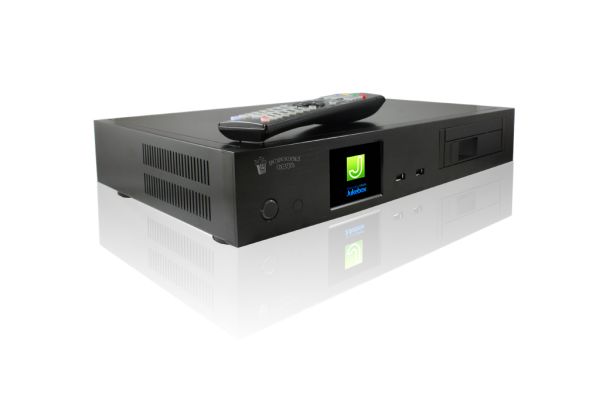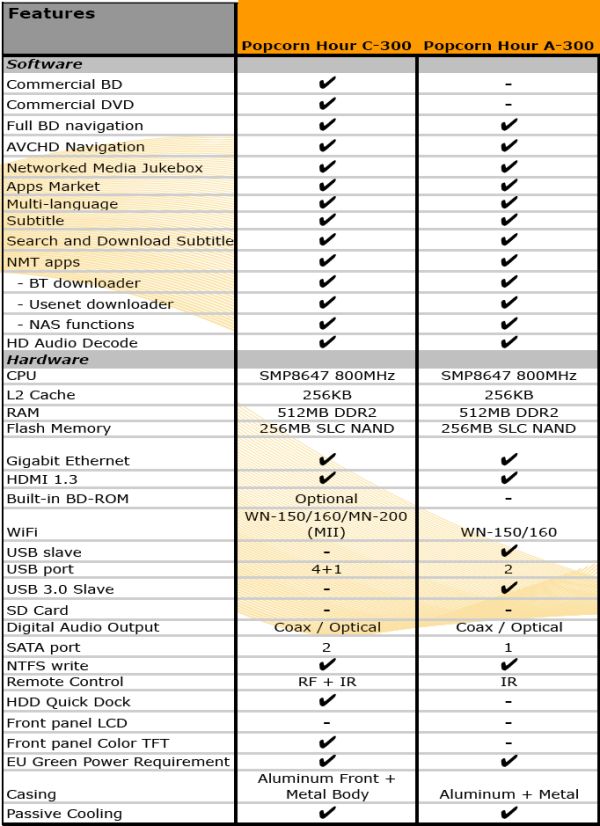Syabas Launches Popcorn Hour C-300
by Ganesh T S on December 6, 2011 3:55 PM EST- Posted in
- Home Theater
- Media Streamer
- HTPC
- Blu-Ray
Syabas launched the second generation version of their BDA licensed unit, the Popcorn Hour C-300 today.
The previous version was based on Sigma's SMP 8643, and the C-300 is based on the SMP 8647. The SMP 8647 SoC (with a 800 MHz MIPS CPU at the core) is also a part of the A-300. Except for the USB 3.0 slave functionality, almost all the interesting aspects of the A-300 are carried over to the C-300.
The C-300's support for an optional built-in BD-ROM enables it to play commercial Blu-rays and DVDs, just like a Blu-ray player. BD-Live functionality is present, though Profile 5.0 Blu-rays are probably not going to play back with full navigation. Compared to the A-300, there are some extra features like support for an RF remote and extra USB ports.
We have had the A-300 review unit for a few weeks and the player is much more stable compared to the Netgear NeoTV 550. There are a few pending bugs in that unit, but none of them are showstoppers. We are waiting for at least one more firmware update before releasing the official review.
As per forum reports, the C-300 should get around 20 - 30 MBps over the GbE port. We observed similar speeds with the A-300 review unit. This is a good improvement over the WDTV Live Hub's 10 - 12 MBps which was the first media streamer with GbE functionality that we reviewed. Like the A-300, the C-300 is also fanless and also has an aluminium body, ensuring noiseless operation. The table below presents a comparison of the features of the C-300 and the A-300.
Like every other media streamer today, we also have an apps market for premium video services. Note that we still don't get HDMI 1.4 or 3D Blu-ray ISO because the SMP 8647 doesn't support it.
The C-300 is expected to ship before Christmas, and it should make an ideal gift for the geeky media streamer fan who also wants full Blu-ray support. Note that Cinavia will be applicable to this unit, as it is an AACS licensed system. However, whether it will be implemented or not is an unknown at this point of time. AACS mandates February 2012 as the cut-off date for all BD players to implement Cinavia. However, it might be only for players manufactured after that date, and it may not make it into previous systems through forced firmware upgrades. We will discuss this further in our official review.
Priced at $349, it costs more than the A-300 (at $219). However, this is the price one needs to pay for the full Blu-ray license. Unless you have an absolute need for playing back full commercial Blu-rays, I strongly suggest going with the A-300 (as there is no threat of Cinavia in that model -- perfect for those playing back backups with their media player).
Head on over to the source link for more information and videos of the UI in action.
Source: Networked Media Tank Forum












6 Comments
View All Comments
mfenn - Tuesday, December 6, 2011 - link
Ganesh,You've mentioned Cinavia a few times now. Can you do a piece explaining what it is and why we should care?
ganeshts - Tuesday, December 6, 2011 - link
mfenn, A Cinavia piece has been in my radar for quite some time now.However, none of the concerned companies are ready to talk about it. I have reached out to Syabas, Sigma Designs, Marvell and Netgear, and I always get the standard response 'We are not in a position to comment about it'. The only time Netgear gave some concrete answers (regarding the NTV550), it turned out to be a false alarm.
Once I get some concrete information from the vendors, I will do a standalone piece. I don't want to spread FUD about this, but this is what I can say for sure:
1. Cinavia is not present in all Blu-ray players right now. Come February, it will become mandatory for all players manufactured after that date (if they want to get an AACS license). It is not clear whether previous players will need to provide a compulsory firmware update. It is also not clear whether the vendors can decide or whether it is upto the SoC company.
2. There is no way to fix Cinavia currently for playback of media protected with that (from NAS / hard drives) when using an affected media player.
3. There is no way to fix Cinavia without molesting the audio track and re-encoding it. (This might turn out to be acceptable for all those screen releases with theater recorded audio). The re-encoding technique hasn't been determined yet, but I don't think this is an insurmountable challenge. In any case, this is not an acceptable method for users backing up Blu-rays.
4. It is best for consumers to avoid AACS / BDA licensed players if they are worried about Cinavia. I strongly believe that the market for players like the A-300 will grow exponentially once Cinavia becomes compulsory.
All in all, it is a well known fact that all these DRM mechanisms only serve to hassle honest customers and make the pirates laugh. Blu-ray is not going to grow much in the future (with the spread of Netflix and similar services), and whatever market the Blu-ray vendors have right now is also going to diminish at a faster rate if they continue to shoot themselves in the foot like what they are doing with Cinavia.
[ This comment makes sure that I will never get any response / comments from the PR people at Verance (the developers of Cinavia) :D ]
tim851 - Wednesday, December 7, 2011 - link
Yeah, it's a testimony of failure that after 10 years of DRM shenanigans, they still don't get it.The People don't copy anymore. Haven't done that in years. Pirates copy. Any DRM arms race is not gonna make it any more difficult for The People, as they have been out it. And The Pirates laugh at the supposed hassles. Or rejoice. A new copy-protection mechanism means an opportunity. If your "group" cracks it first, you gain a tremendous advantage in competition. Like the Skidrow crew who seem to be the only ones with a reliable way to crack Steam protection.
The only thing that DRM has done is create an actual shadow economy. Thousands of people who earn money off the fact that for the average joe it has become to difficult (and legally dangerous) to copy a movie by themselves.
It's basically the Marihuana-idiocy all over again. Marihuana is by all account safer than alcohol, yet there's been this stupid "war" on it that has not gotten rid of it, but deprived the state of tax income and provided thousands of dealers with an easy way to make money.
TerdFerguson - Wednesday, December 7, 2011 - link
Wikipedia does a better job explaining this technology, in my opinion, than our dear author. See: http://en.wikipedia.org/wiki/CinaviaBasically, it's a "watermark" embedded into an audio track. The watermark will survive encoding/decoding and even re-recording, such as with a microphone in a movie theater. Devices that support AACS, and thus Cinavia, will detect the watermark and compare it to internal (or online) tables to determine whether or not to allow playback.
You should care both because it is another threat to your ability to enjoy watching movies the way you want (time-shifted or on your portable device, for example) and because it opens the door for internet-connected media players to phone home with reports of your viewing habits.
ganeshts - Wednesday, December 7, 2011 - link
I already assumed that people know what Cinavia is :) I was trying to get into the details of what consumers need to be aware of in order to avoid that issue.Arbie - Wednesday, December 7, 2011 - link
I have a Popcorn Hour C-200, one of their premier products at around $350.Support is TERRIBLE. Even two years after release it remains plagued with idiotic user interface glitches and major problems with music playback, at least. Constant requests for even the simplest improvements e.g. in navigation fall on deaf ears. The Syabas / PCH team seems to make one stab at the basics, then move on to whatever esoteric bells and whistles they - as expert users - want to have. Or on to other products, all of which get the same cursory treatment.
It's like a hobby machine, but made on an assembly line.
And not a very reliable assembly line. Check the Popcorn forums for yourself, at "networkedmediatank.com". There are probably a dozen threads on failed C-200 power supplies, one of which has over 7,000 views! And Syabas has done nothing for all these people.
Firmware updates are too infrequent to begin to address all the problems. And here's another example of their total inward focus: you can't update the firmware unless you have a working internet connection to the box! Since that's one of the many things I've found hopelessly difficult to establish, I'm dead in the water regarding any further "improvements".
Syabas / Popcorn have some good ideas (maybe too many). But they sell unfinished products and, worse, never do finish them. Once they have your money, you no longer matter at all.
Ignore the hype and fancy claims. "Plays all your media files!" Some, yes; sometimes; but probably not for very long.